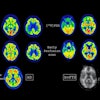
Structured reporting enables radiologists to produce reports that are more standardized and easier to understand by referring physicians than those produced in traditional prose style, according to researchers from University Hospital Basel in Switzerland.
A team led by Dr. Jan Vosshenrich evaluated more than 1 million radiology reports and found that the adoption of structured reporting produced measurable changes in the language of the reports. The structured reports were clearer and less variable.
 Dr. Jan Vosshenrich of University Hospital Basel.
Dr. Jan Vosshenrich of University Hospital Basel."Both radiologists and clinicians benefit from increased standardization of language in terms of readability, comparability, and also comprehensibility," Vosshenrich said.
He presented the research during a scientific session at RSNA 2019 in Chicago.
Radiology reports are vital for patient care, but the variability of traditional prose-style reports can make it difficult for clinicians to identify key information. The resulting dissatisfaction with the variation and ambiguity that can occur in traditional reports has led to the use of structured reporting in recent years, according to Vosshenrich.
Furthermore, many radiology societies now recommend use of the method to unify reporting and ensure the value of radiologists' work for both clinical colleagues and patients, he explained.
Macroscopic assessment
Numerous studies in the literature have directly compared structured and unstructured reports for specific clinical questions, but the University Hospital Basel researchers sought to explore the effects of structured reporting on a macroscopic level and investigate overall trends in language patterns.
"Structured reporting is strongly advertised in our department and plays a prominent role both in clinical routine as well as in research projects," Vosshenrich told AuntMinnieEurope.com. "Several of our subspecialty sections [have used] 100% structured reports since early 2016, providing us with a vast amount of data for analysis. Apart from introducing template-based structured reporting, strong emphasis was placed on a clear, distinct, factual reporting language without elements of hedging or unnecessary uncertainty."
To assess the effect of structured reporting on radiology reporting language, they extracted more than 1.3 million radiology reports from their RIS that were produced between 2011 and 2018. Structured reporting templates had been introduced in the body and chest imaging sections during that time period, while the musculoskeletal and neuroradiology sections continued reporting in prose style.
The investigators then used a linguistic natural language processing approach to automatically separate and segment the findings and impression sections of the reports. These sections were segmented into part-of-speech categories based on character count as well as total words, nouns, verbs, and adverbs.
The data were aggregated on a monthly basis and analyzed statistically and graphically. Further data clustering with t-distributed stochastic neighbor embedding (t-SNE) plots was performed to reduce dimensionality of the data, Vosshenrich noted.
A clear effect
The adoption of structured reporting resulted in lower mean character counts, unique word counts, and variability in the findings section, as well as higher mean character counts, unique word counts, and variability in the impression section, the group found.
| Radiology report metrics by reporting method | |||
| Prose reporting | Structured reporting | Percentage change | |
| Mean character count -- findings section | 240.4 | 101.5 | 57.8% |
| Mean unique word count -- findings section | 24.5 | 11.6 | 52.7% |
| Mean character count -- impression section | 286.4 | 337.4 | 17.8% |
| Mean unique word count -- impression section | 30 | 35.1 | 17% |
The standardization of the findings section improved due to checklists and prepopulated reporting templates, according to Vosshenrich.
"The variation of impression section, in contrast, increases because we think there's a growing effort to put structured or checklist-type findings into the right perspective for the individual patient," he said.
Structured and, hence, standardized reporting paves the way for big data analysis and natural language processing in radiology to gain new insights into the description of normal and pathologic conditions, Vosshenrich noted.
"Ultimately, even the creation of predictive algorithms, as we are accustomed to from search engines and messaging services, suggesting organ- or disease-specific terms to the radiologist when reporting an imaging study, is now a realistic scenario," he said.



















